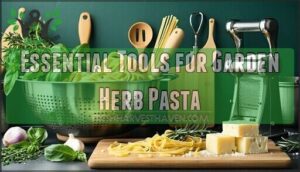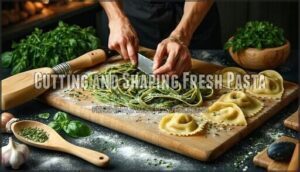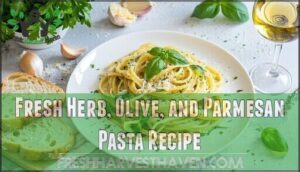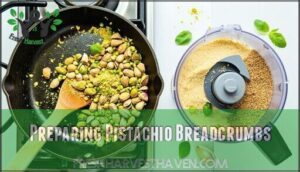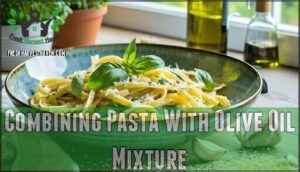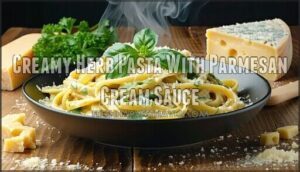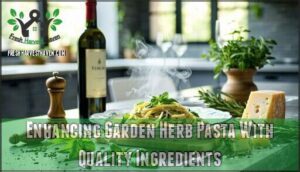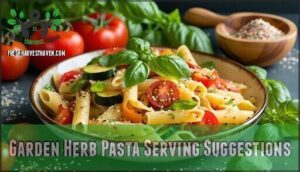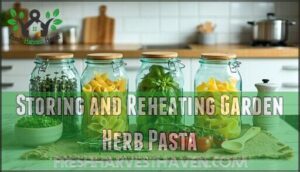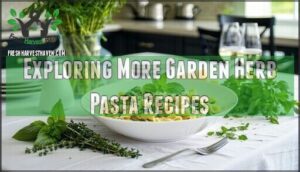This site is supported by our readers. We may earn a commission, at no cost to you, if you purchase through links.
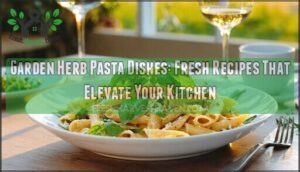
Fresh basil, oregano, and thyme transform simple pasta into aromatic masterpieces that’ll have your family asking for seconds.
These dishes work magic when you pair garden-fresh herbs with quality olive oil and parmesan cheese.
The beauty lies in their flexibility—you can swap herbs based on what’s growing in your garden or what’s available at the market.
Whether you’re tossing linguine with herb-infused oil or creating creamy parmesan sauces studded with fresh parsley, these recipes deliver bold flavors.
The secret techniques for maximizing herb flavor will surprise you.
Table Of Contents
- Key Takeaways
- Fresh Herb Pasta Basics
- Essential Tools for Garden Herb Pasta
- Making Pasta From Scratch With Garden Herbs
- Herb and Olive Oil Pasta Recipe
- Creamy Herb Pasta With Parmesan Cream Sauce
- Enhancing Garden Herb Pasta With Quality Ingredients
- Garden Herb Pasta Serving Suggestions
- Storing and Reheating Garden Herb Pasta
- Exploring More Garden Herb Pasta Recipes
- Frequently Asked Questions (FAQs)
- What goes well with Herb pasta?
- What are healthier alternatives for pasta?
- Which Herb goes best with spaghetti Italiano?
- Which parsley is best for pasta?
- How do you eat garlic drained pasta?
- How do you Cook re-served pasta?
- What fresh herbs go well with pasta?
- What to make with herbs from garden?
- What is pappardelle pasta good for?
- When to put herbs in pasta?
- Conclusion
Key Takeaways
- You’ll create restaurant-quality pasta dishes at home by combining fresh garden herbs like basil, oregano, and thyme with quality olive oil and parmesan cheese for maximum flavor impact.
- You can master herb timing by adding delicate herbs like basil and parsley during the final minute of cooking while letting sturdier herbs like rosemary and thyme simmer longer in sauces.
- You’ll achieve the best results by using high-quality ingredients including extra virgin olive oil, freshly grated parmesan, and freshly ground pepper to complement your garden-fresh herbs.
- You can customize your dishes based on what’s growing in your garden or available at the market, swapping herbs and experimenting with different pasta shapes to create endless flavor combinations.
Fresh Herb Pasta Basics
You’ll master fresh herb pasta when you understand which herbs work best with different sauces and pasta shapes.
Fresh herbs like basil, parsley, and thyme transform simple pasta into restaurant-quality dishes that showcase bright, earthy flavors.
Garden herbs turn everyday pasta into culinary magic with their vibrant, aromatic essence.
Choosing The Right Herbs for Pasta
Several herbs transform ordinary pasta into culinary gold.
Herb pairing creates perfect flavor profiles – basil’s sweet notes complement tomato sauces, while oregano’s earthy essence enhances cream bases.
Italian herb pasta benefits from aromatic oils released through proper herb blending.
Fresh thyme and parsley brighten dishes, making your herb infused pasta shine.
Choose herbs that match your sauce’s personality.
For an invigorating twist, consider incorporating pasta salad elements into your dishes.
Preparing Fresh Herbs for Pasta
Fresh herbs transform ordinary noodles into extraordinary garden herb pasta dishes.
Here’s your path to perfect Herb Washing and preparation:
- Rinse gently under cool water to remove dirt
- Pat completely dry with paper towels for Herb Drying
- Stack and roll leaves tightly together
- Slice into ribbons with your sharpest knife for Fresh Chopping
This careful technique preserves Aromatic Oils for maximum Flavor Enhancement.
Mastering these steps can help you create delicious dishes using easy fresh herb recipes that elevate your kitchen.
Using Fresh Herbs in Pasta Recipes
Three Herb Pairings transform ordinary pasta into garden herb pasta dishes.
Add delicate herbs like basil and parsley during the final minute to preserve their vibrant Pasta Flavors.
Robust rosemary and thyme can simmer longer in sauces.
Fresh Combinations like mint with peas or oregano with tomatoes create herb-infused pasta dishes.
These Herb Benefits and Seasonal Ingredients elevate every bite naturally.
Essential Tools for Garden Herb Pasta
Making fresh herb pasta recipes becomes effortless when you’ve got the right equipment in your corner. Your kitchen arsenal should include sharp Kitchen Knives for precise herb chopping and a reliable Pasta Machine for creating silky sheets.
Herb Cutters like mezzalunas work wonders for delicate leaves, while accurate Measuring Cups guarantee perfect ratios in your garden herb sauce.
Don’t forget these game-changers:
- Large Colander: Drains pasta quickly while preserving those tender herb pieces.
A quality cheese grater transforms your pasta with herbs into restaurant-worthy dishes. Whether you’re crafting herb and cheese pasta or perfecting that herb cream sauce, these tools make the difference between amateur and amazing results.
To create the perfect garden herb pasta, understanding tomato sauce basics is essential for a delicious and well-rounded flavor profile.
Making Pasta From Scratch With Garden Herbs
You’ll transform basic flour and eggs into silky pasta ribbons that capture the earthy essence of your garden herbs.
Fresh basil, parsley, and thyme blend directly into the dough, creating vibrant green streaks that deliver aromatic flavor in every bite, with the earthy essence of the herbs.
Pasta Dough Recipe
Creating your own herb-infused pasta transforms simple ingredients into something extraordinary.
Transform simple flour and herbs into extraordinary pasta that captures your garden’s vibrant essence.
Start with proper Flour Mixing—combine 200g "00" flour with 200g semolina flour and salt in a bowl. Create a well for eggs and olive oil, then mix until shaggy.
Dough Resting is essential for texture development; let it rest 30 minutes minimum. Your Ingredient Ratio matters for perfect consistency.
To achieve the best results, understanding pasta making techniques is essential for creating delicious garden herb pasta dishes.
| Ingredient | Amount | Purpose |
|---|---|---|
| "00" Flour | 200g | Structure |
| Semolina Flour | 200g | Texture |
| Eggs | 3-4 large | Binding |
| Salt | 1 tsp | Seasoning |
Tips for Kneading and Rolling Pasta
When your herb-infused pasta dough feels smooth and slightly elastic, you’re ready to transform it into silky sheets.
Perfect pasta texture starts with proper dough hydration and consistent kneading techniques.
Here’s how to nail your rolling methods:
- Work the dough for 8-10 minutes until it springs back when poked
- Let it rest 30 minutes wrapped in plastic for better pasta consistency
- Roll gradually from thick to thin settings on your pasta machine
Your homemade pasta should feel like silk between your fingers—that’s when you know it’s ready for cutting!
Cutting and Shaping Fresh Pasta
Once your herb-infused dough reaches perfect consistency, transforming it into beautiful shapes becomes pure joy.
Your pasta cutting technique determines the final texture and presentation.
- Master knife skills by slicing even ribbons with a sharp blade for rustic fettuccine
- Perfect dough folding creates elegant filled pasta like herb-stuffed ravioli
- Experiment with fresh shapes using cookie cutters for playful herb garlic pasta variations
Each cut releases aromatic herb seasoning throughout your dish.
To enhance the flavor, consider using simple pesto recipes that incorporate fresh basil and other herbs.
Herb and Olive Oil Pasta Recipe
You’ll create a timeless pasta dish that showcases your garden’s freshest herbs with just olive oil and Parmesan cheese.
This simple recipe transforms basic ingredients into an aromatic meal that tastes like summer on your plate.
Fresh Herb, Olive, and Parmesan Pasta Recipe
Angel hair pasta becomes a canvas for your garden’s bounty in this simple recipe.
Toss your freshly made pasta with extra virgin olive oil, minced garlic, and chopped fresh herbs like basil and parsley.
Add freshly grated Parmesan cheese and a splash of pasta water to create that silky coating.
The delicate pasta textures perfectly complement the bright herb pairings and nutty cheese flavors.
Preparing Pistachio Breadcrumbs
Your herb pasta deserves a showstopping crunchy topping. These pistachio breadcrumbs transform ordinary garlic herb pasta into something extraordinary.
Start by toasting shelled pistachios in a dry skillet for three minutes. The nutty flavor deepens as they warm. Let them cool completely before processing.
- Pulse pistachios with panko breadcrumbs until you get varied textures—some fine crumbs, some chunky pieces
- Add fresh herbs like parsley or basil to complement your herb pasta recipes
- Include a pinch of garlic powder for extra depth that pairs perfectly with herb fettuccine alfredo
This pistachio crunch creates the perfect breadcrumb texture that’ll make your herb garlic shrimp pasta unforgettable.
Combining Pasta With Olive Oil Mixture
Effortlessly bringing together your cooked pasta with the fragrant olive oil mixture creates the foundation for exceptional herb-infused pasta. This step transforms simple ingredients into something extraordinary through proper technique and timing.
The secret lies in creating perfect oil ratios that coat each strand without overwhelming the delicate herb infusions. Your pasta pairings depend on achieving the right balance between oil temperature and herb intensity.
Here’s how to master this vital combination:
- Toss warm pasta immediately with the herb garlic mixture while both are hot
- Use gentle folding motions to preserve delicate herb leaves and prevent breaking
- Add reserved pasta water gradually to create silky emulsification and proper consistency
- Taste and adjust seasoning before serving to guarantee balanced flavor profiles
This technique guarantees your olive oil blends distribute evenly, creating restaurant-quality herb pasta recipes that showcase your garden’s bounty perfectly.
Creamy Herb Pasta With Parmesan Cream Sauce
You’ll transform simple pasta into restaurant-quality comfort food with this rich Parmesan cream sauce that perfectly balances tangy cheese and fresh herbs.
This creamy dish combines heavy cream, freshly grated Parmesan, and aromatic garden herbs like basil and parsley for a velvety sauce that coats every strand.
Creamy Herb Pasta Recipe Overview
Moving beyond simple olive oil preparations, creamy herb pasta brings restaurant-quality flavors to your home kitchen.
This luxurious dish combines fresh seasonal ingredients with rich creamy textures that coat every strand perfectly.
The herb-infused dishes showcase vibrant flavor profiles from garden-fresh basil, parsley, and thyme.
Herb blends create complex pasta sauces with subtle lemon flavor notes.
Ready in minutes, this creamy herb pasta transforms ordinary weeknight dinners into something special.
Preparing The Parmesan Cream Sauce
Your creamy pasta adventure begins with mastering the perfect Parmesan Sauce. Start by melting butter over medium heat, then create your Cream Base through careful layering:
- Melt unsalted butter until it bubbles gently without browning
- Whisk minced garlic for 30 seconds to achieve Flavor Enhancement
- Add flour and whisk constantly to form a smooth roux
- Pour heavy cream slowly while stirring to control Sauce Thickness
- Remove from heat before Cheese Blending freshly grated parmesan cheese
This technique creates silky creamy pasta sauces that coat every strand. Herb-infused pasta dishes benefit from this rich foundation, while lemon flavor brightens creamy lemon pasta when added at the final stage.
Tossing With Cooked Pasta and Garnishing
Now comes the magic moment – the pasta toss. Reserve some pasta water before draining, then gently fold warm noodles into your parmesan cream sauce. The starch creates silky perfection.
| Technique | Result |
|---|---|
| Herb Garnish | Color and aroma boost |
| Fresh Sprinkles | Textural contrast |
| Olive Drizzle | Rich finishing touch |
| Garlic Finish | Savory depth |
| Lemony Pasta | Bright, tangy sauce balance |
Top with fresh sprinkles of chopped herbs. Your herb infused dishes need that final olive drizzle for restaurant-quality shine.
Enhancing Garden Herb Pasta With Quality Ingredients
You’ll transform your garden herb pasta from good to extraordinary when you choose premium ingredients that complement your fresh herbs.
Quality olive oil, aged cheese, and freshly ground pepper create layers of flavor that make each bite memorable and satisfying, with fresh herbs being a key component.
Using High-Quality Olive Oil
Quality transforms your herb-infused pasta dishes from ordinary to extraordinary. Premium ingredients make garden-fresh ingredients sing with flavor.
Extra virgin olive oil delivers the Olive Oil Benefits your herbs deserve. Here’s what creates perfect Oil Pairing:
- Cold-pressed varieties preserve Aromatic Profiles and Oil Quality
- Fruity or peppery notes complement Herb Pairings beautifully
- Italian or Greek origins offer authentic Flavor Enhancement
- Lower cooking temperatures protect delicate herb flavors
- Dark glass bottles maintain freshness longer
The right olive oil elevates your premium ingredients into restaurant-quality pasta that’ll have everyone asking for seconds. Using high-quality extra virgin options is essential for achieving the best flavor.
Selecting The Right Cheese for Pasta
Cheese selection transforms your garden herb pasta from ordinary to extraordinary.
Understanding Cheese Pairing with different Pasta Types creates harmony between creamy textures and fresh herbs. Cheese Texture matters—ricotta cheese melts smoothly into delicate sauces, while aged parmesan cheese adds sharp complexity.
Flavor Profiles vary dramatically with Cheese Aging, affecting your creamy pasta experience.
| Cheese | Best Herb Match | Texture Quality |
|---|---|---|
| Parmesan | Basil, oregano | Sharp, granular |
| Ricotta | Mint, parsley | Smooth, mild |
| Pecorino | Rosemary, thyme | Tangy, firm |
Fresh cheese sauce elevates simple herbs, while creamy dressings bind flavors beautifully together.
Adding Freshly Ground Pepper
After you’ve selected quality cheese, a pepper mill transforms your herb-infused pasta into something extraordinary.
Fresh grind pepper releases aromatic oils that pre-ground versions can’t match. Your garden-fresh ingredients deserve this extra attention to seasoning tricks.
- Black peppercorns provide classic warmth that enhances basil and oregano in herb-rich pasta recipes
- Pink peppercorns offer fruity notes perfect for delicate herb-infused dishes with chives or parsley
- White pepper delivers subtle heat without masking your herbaceous flavors
These grinding tips elevate pepper flavor substantially.
Garden Herb Pasta Serving Suggestions
You can transform your garden herb pasta from a simple dish into an impressive meal with smart serving choices.
Fresh cherry tomatoes and roasted vegetables create colorful contrasts that complement the earthy herbs while adding new textures and flavors, making the dish more impressive.
Adding Cherry Tomatoes as a Garnish
Cherry tomatoes transform ordinary garden herb pasta dishes into vibrant culinary masterpieces.
These colorful gems bring bright, sweet-tart flavors that complement herb-infused pasta beautifully.
Fresh garnish doesn’t get much better than this.
Here’s your guide to perfect pasta toppings:
- Select diverse varieties – Mix red, yellow, and orange cherry tomatoes for stunning visual appeal
- Master tomato slicing – Halve larger ones, keep tiny varieties whole for texture contrast
- Warm gently – Let residual pasta heat soften tomatoes slightly for enhanced flavor release
- Time it right – Add these garnish ideas just before serving to maintain freshness and aroma
Your fresh herb dishes deserve this simple yet elegant finishing touch.
Serving With Roasted Vegetables
Beyond cherry tomatoes, roasted vegetables transform your garden herb pasta dishes into restaurant-worthy masterpieces.
Roasted carrots and grilled asparagus create stunning seasonal pairings with herb-infused pasta dishes. Toss your chosen vegetable medley with olive oil and fresh herbs before herb roasting at 425°F for 20-25 minutes until caramelized.
These roasted vegetable pasta combinations elevate simple garden-fresh pasta recipes into vegetable-forward pasta dishes. Match earthy root vegetables with thyme pasta during fall, or pair zucchini and bell peppers with basil noodles in summer.
Your herb-infused pasta dishes deserve these colorful, flavorful companions. To achieve the perfect flavor, consider using canning methods to preserve your garden harvest and enjoy it year-round.
Storing and Reheating Garden Herb Pasta
You’ll want to store your garden herb pasta properly to maintain those fresh, vibrant flavors for future meals.
Proper storage and reheating techniques guarantee your herb-infused pasta tastes just as earthy and aromatic as when you first made it.
Freezing Fresh Pasta
Pasta freezing becomes your secret weapon when you’ve crafted too many herb-infused pasta dishes to enjoy immediately. Proper frozen storage guarantees your garden-fresh ingredients maintain their vibrant flavors for weeks ahead.
Here’s how to master pasta preservation like a pro:
- Dust fresh pasta lightly with flour to prevent clumping during storage
- Portion your herby pasta recipes into single-serving amounts before freezing
- Use airtight containers or heavy-duty freezer bags for maximum freezer safety
- Lay pasta flat on baking sheets initially, then transfer to storage containers
- Label each package with preparation date and specific herb varieties used
Your herb gardening efforts deserve this careful preservation approach. When properly stored, frozen herb-infused pasta maintains quality for up to three months. Thawing techniques are simple—cook directly from frozen or thaw overnight in your refrigerator for best results.
Refrigerating Cooked Pasta
With your herb-infused pasta dishes perfectly prepared, proper pasta storage becomes your next mission for preserving those garden-fresh ingredients.
Cool your creation completely before transferring to airtight containers—this prevents condensation that kills fresh flavors. Store sauce separately from noodles to avoid mushiness, and drizzle olive oil lightly over pasta to prevent sticking.
| Storage Method | Temperature | Duration |
|---|---|---|
| Refrigerator | 40°F (4°C) | 3-5 days |
| Airtight Container | Below 40°F | Maximum freshness |
| Separate Storage | Cold temp | Best texture |
Follow these refrigeration tips for ideal leftover management and food safety with your pasta salad recipes, ensuring proper pasta storage and maintaining the fresh flavors of your dish, which is crucial for ideal leftover management.
Reheating Pasta for Later Use
Most leftover storage situations don’t need to spell disaster for your herb-infused pasta dishes.
Gentle reheating pasta preserves those delicate herb pairings you worked so hard to perfect. Add a splash of water or broth to prevent sticking and maintain texture.
- Stovetop method: Warm over medium-low heat, stirring occasionally for even heating
- Microwave tips: Cover with damp paper towel, heat in 30-second intervals
- Food safety: Confirm internal temperature reaches 165°F before serving
Your reheat methods determine whether pasta dishes taste freshly made or disappointingly dry.
Exploring More Garden Herb Pasta Recipes
You can expand your garden herb pasta repertoire by experimenting with unique herb blends like mint and parsley or thyme and oregano.
Different pasta shapes will hold these aromatic combinations differently, creating new textures and flavor experiences in your kitchen, with unique herb blends.
Discovering New Herb Combinations
When you’re ready to transform ordinary meals into extraordinary experiences, herb pairing becomes your secret weapon.
Create dynamic flavor profiles by blending bold rosemary with gentle parsley, or craft unexpected aromatic blends like mint-basil combinations.
Your botanical mix adventures can include regional culinary fusions such as Herbes de Provence.
These herb-infused pasta dishes showcase garden-fresh ingredients that turn simple herb combinations into memorable herb-rich dishes and vibrant lemon herb pasta creations.
Experimenting With Different Pasta Shapes
Different pasta shapes transform your herb-infused pasta dishes into exciting culinary adventures.
Tube pastas like rigatoni capture chunky herb sauces, while flat noodles such as fettuccine showcase delicate herb oils beautifully.
Long strands of angel hair work perfectly with light, garden-fresh ingredients, but heartier shape variations like shells cradle herb-rich pasta creations better.
Each form affects texture and sauce distribution differently.
Experimenting with various shapes keeps your vegetable-based pasta dishes fresh and interesting, turning simple herbs into restaurant-quality meals.
Understanding various pasta shape options is essential for creating diverse herb-infused recipes.
Finding Inspiration From Other Recipes
Beyond experimenting with pasta shapes, you’ll find endless inspiration when you explore recipe swaps from different culinary traditions.
Your herb-infused pasta dishes can transform dramatically by borrowing cooking techniques and flavor profiles from around the world.
Start building your personal collection of herb-rich dishes by adapting recipes to match your garden-fresh ingredients. Recipe swaps don’t require complicated changes – sometimes switching basil for cilantro creates an entirely new experience.
Consider these approaches for your meal planning:
- Global fusion: Combine Italian pasta with Thai herb combinations like mint and cilantro
- Seasonal adaptations: Swap winter herbs for spring varieties based on current food trends
- Dietary modifications: Transform cream-based recipes into lighter, herb-focused versions
- Regional influences: Try Mediterranean pasta herb seasoning blends with local ingredients.
Each adaptation teaches you something new about herb combinations while keeping your cooking fresh and exciting.
Frequently Asked Questions (FAQs)
What goes well with Herb pasta?
You’d think herb pasta needs complicated sides, but it’s actually quite simple.
Grilled chicken, roasted vegetables, or crusty bread complement the fresh flavors perfectly.
A light salad adds crunch and balance.
What are healthier alternatives for pasta?
You’ll love swapping regular pasta for zucchini noodles, spaghetti squash, or shirataki noodles.
These alternatives cut calories while adding nutrients.
Whole grain pasta and legume-based options like chickpea or lentil pasta boost protein too.
Which Herb goes best with spaghetti Italiano?
Like finding the perfect dance partner, basil’s your go-to herb for spaghetti Italiano.
Its sweet, peppery notes complement tomato-based sauces beautifully.
You’ll want fresh basil leaves torn by hand, not chopped, to preserve those essential oils.
Which parsley is best for pasta?
Flat-leaf parsley wins hands down for pasta dishes.
It’s got more flavor punch than curly parsley and won’t wilt as quickly when you toss it with hot noodles.
Your taste buds will thank you.
How do you eat garlic drained pasta?
Ever wonder why simple pasta feels so satisfying?
You’ll twirl garlic-drained pasta onto your fork, savoring each aromatic strand.
The key’s eating it immediately while hot, letting those garlicky oils coat your palate perfectly.
How do you Cook re-served pasta?
Reheat leftover pasta by adding it to a hot skillet with a splash of water or broth.
Toss gently for two minutes until warmed through.
You’ll revive the texture without overcooking or drying out your dish.
What fresh herbs go well with pasta?
You’ll love basil, parsley, oregano, and thyme with pasta – they’re versatile crowd-pleasers.
Fresh rosemary and sage add aromatic depth, while mint brings surprising freshness.
Add herbs at cooking’s end to preserve their vibrant flavors and ensure the dishes remain crowd-pleasers.
What to make with herbs from garden?
Fresh garden herbs shine in homemade pesto, herb-infused pasta dough, and vibrant sauces.
You’ll create flavorful combinations with basil, parsley, thyme, and oregano that transform simple noodles into restaurant-quality dishes bursting with aromatic garden goodness.
What is pappardelle pasta good for?
Pappardelle’s wide, flat ribbons perfectly capture chunky sauces like hearty mushroom ragù or rich meat bolognese.
You’ll love how its broad surface holds creamy herb butter sauces, making every bite flavorful and satisfying with rich meat bolognese.
When to put herbs in pasta?
Add delicate herbs like basil and parsley during the last minute of cooking to preserve their bright flavor. Sturdier herbs like rosemary and thyme can simmer longer with your sauce.
Conclusion
Ironically, the simplest dishes often deliver the most complex flavors.
You’ve discovered how garden herb pasta dishes transform ordinary ingredients into extraordinary meals.
Fresh herbs elevate basic pasta beyond recognition, creating restaurant-quality results in your home kitchen.
These techniques reveal bold, aromatic combinations that’ll keep your family coming back for more.
Start with quality olive oil, add garden-fresh herbs, and watch simple pasta become something special.
Your kitchen will never smell the same again.
- https://foodrevolution.org/blog/cooking-with-herbs-and-spices-fresh-vs-dried/
- https://www.scienceoftaste.com/articles/growing-spices-herbs-guide/
- https://www.researchgate.net/publication/348676994_Mediterranean_aromatic_herbs_and_their_culinary_use
- https://www.vrg.org/journal/vj2013issue2/VJIssue22013.pdf
- https://www.thespruceeats.com/classic-spice-and-herb-blends-1328612

